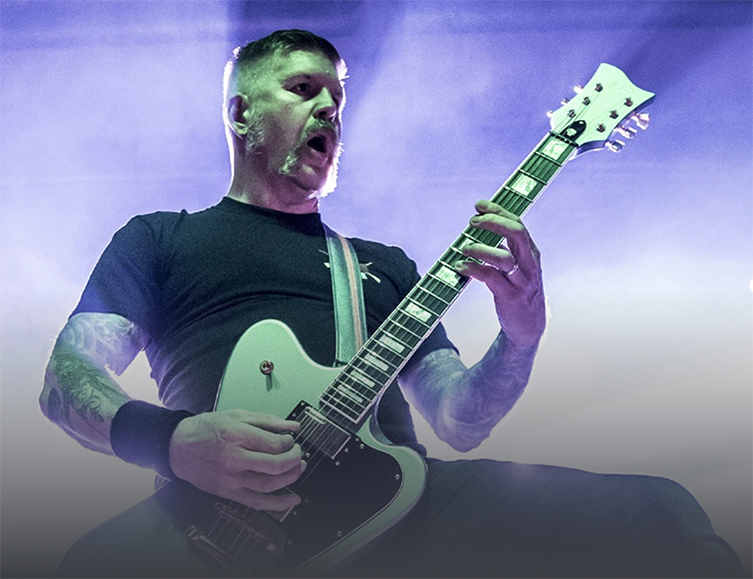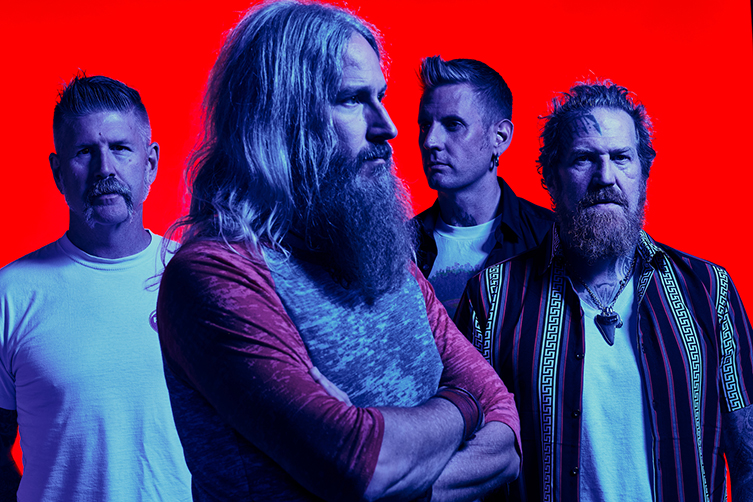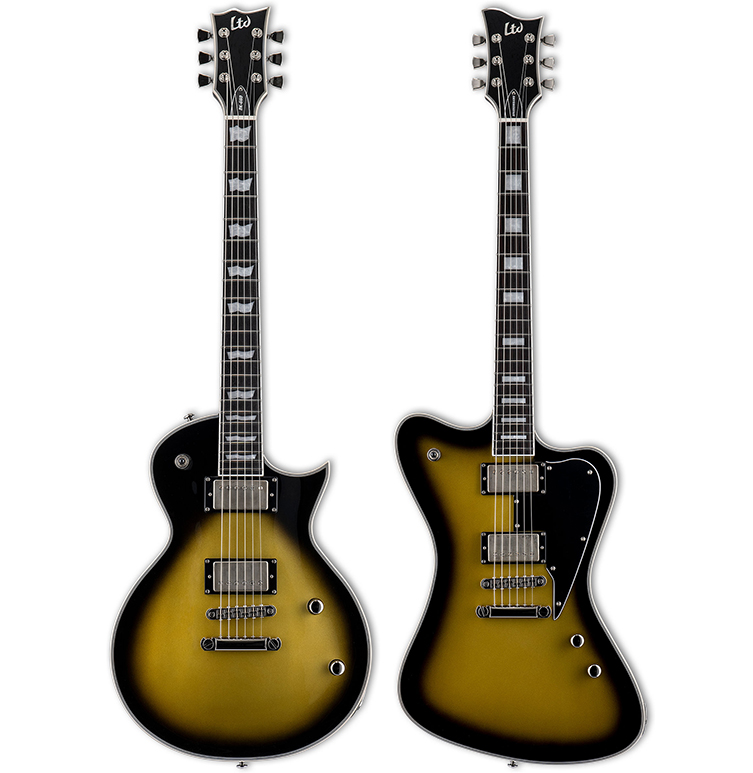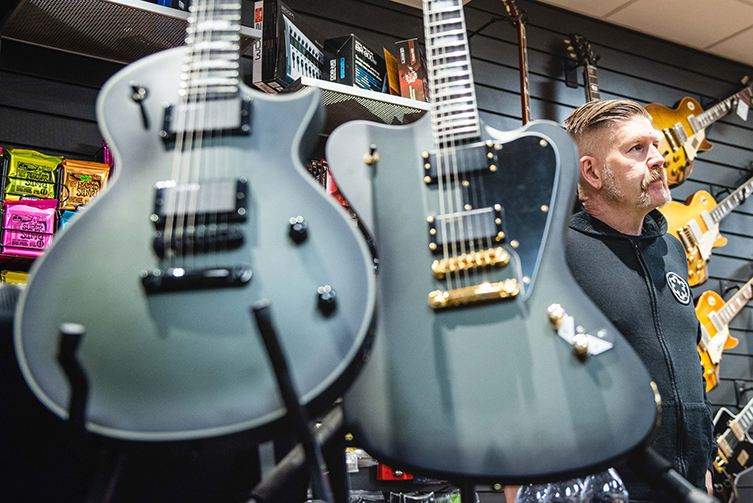Mastodon: a large, hairy, elephant-like mammal that roamed North America until about 13,000 years ago.
See also: a kick-ass progressive, alternative metal band from Atlanta Georgia who absolutely ripped up the rulebook and changed the game for heavy music.
Mastodon are one of the modern greats when it comes to guitar music. It’s high time that I explored their sound with you anyway, but the recent tragic passing of Brent Hinds only makes this more timely. I’ll generally talk about the band as a four piece that contains Brent, since what other way could I discuss their body of work? Replacement guitarists and touring keyboardists won’t be showing up today: this is about the classic lineup.

(Pic: Clay Patrick McBride)
In Brent’s honour, then, we stride forward and check out the gear, tunings and techniques of this most uniquely awesome band.
Contents
Mastodon Playing Techniques, Styles and Tips
Rounding Up, with some Final Words from Bill
Thee Singers, Two Guitarists
- Everyone in Mastodon performs vocal duties to some degree or another
- There are no straight rhythm and lead roles for the guitarists
- That said, Hinds was took the majority of the solos
Mastodon have a traditional four piece rock band lineup: two guitars, bass, drums. Whilst I would say that Brent Hinds WAS the lead guitarist - he performed the overwhelming share of solos and such - co-guitarist Bill Kelliher is also a serious player, and adds a lot of symphonic and melodic parts of his own. Rather than being a strict rhythm-and-lead situation, it’s weirdly more like how Keith Richards and Ronnie Wood in the Stones ‘weave’ their parts together to create a tapestry. This requires two guitarists for sure, since both people are playing a number of different parts within a song.
Vocal-wise (and not something we are looking at much today), Mastodon defied normal band hierarchies by having not one, not two but three lead vocalists! Indeed, only guitarist Bill doesn’t take the mic for any leads, though he still joins in on shouts and screams. With Brent leaving the band a few months before his death, bassist Troy Sanders and drummer Brann Dailler took on more of the vocal duties.
So, the short of it is: there’s a lot going on inside Mastodon’s music!
Before I look at the gear they use, I actually want to dive into the playing styles of Brent and Bill, to try to decipher some of their art…

(Pic: Clay Patrick McBride)
Mastodon Playing Techniques, Styles and Tips
- Practice is required
- Despite making ‘busy’ music, not a moment or note is wasted
- Influences range from country to classical
With a band as big and successful as Mastodon, there’s going to be a large body of work to refer to. I’ll pick out some examples that will hopefully clarify the points I want to make, but I should say that there are lots of deeper, further examples you’ll come across as you venture into their universe.
This is not easy music to play. There are rarely occasions when the band simply ride on a chord progression, or play a straightforward power chord riff. This is twisty, labyrinthine stuff and will be a challenge to even the more seasoned players out there. Most of the riffs are easy enough to get under your fingers, but try a full song - with all the changes in rhythm, metre, key and position - and you’ll soon see what I mean. This lot are a bunch of titanic musicians!

(Pic: Clay Patrick McBride)
Pick & Fingers
Brent Hinds was a big banjo player outside (and occasionally within) Mastodon. This influence drifted across into his guitar playing in quite a fundamental way. Hinds adopted a special picking technique that we call hybrid pick & fingers, and here’s the basic method:
- Hold your pick as normal with thumb and index finger.
- Keep your right hand hovering over the strings, not anchored to the bridge with your palm.
- Use your right hand middle and ring fingers to pick strings on (mostly) the G and B strings.
- The pinky can be used for high E string notes, or you can shift your hand position.
- The pick is used primarily for notes on the lower three strings (E, A and D) though in reality, you shift and adapt to whatever the music requires.
It's a tricky technique to perfect, but an excellent one to have in your box of tricks! Watch Brent's right hand here for an apt demonstration!
Open Strings
Mastodon made excellent use of open strings in their music. Riffs, arpeggios and lead lines could all often include open strings as either pedal tones (a constant low harmonic reference point) or just to spice up arpeggios with note clusters that are impossible to achieve with only fretted notes.
Bill himself had this to say about it: "Almost every single song has 10 or 12 open notes. Almost anytime I want to play a note that's also an open string, I'll go for the open string.”
Check out the bridge and solo section of Oblivion (the parts underneath the solo) for some good examples of this.
Chromaticism
In that last example, you heard some distinctly ‘seasick’ notes! That deliberate strangeness is achieved by utilising chromaticism, which in this respect refers to using adjacent notes in the chromatic scale. (Without getting too technical, the E chromatic scale is all 12 notes from E to E, so every fretted note). It’s almost like willfully playing incorrect notes, but because it's part of a repeating sequence and played with intention, you know that it's a deliberate decision. Much of the semi-chaotic instrumental sections here are carefully thought out chromatic runs:
Chromaticism can really add some bizarre energy to your music as long as you utilise it from a point of experience, not an excuse for hitting the wrong notes! Hear more in the song Quintessence, where the off-kilter parts are contrasted with more straightforward hard rock to provide both respite and contrast from the oddness. Light and shade, people!
Harmony
Guitar harmonies can quite easily land you in cheesy waters, but Mastodon seem to have taken their inspiration from orchestral music rather than Wishbone Ash or whatever. There are many examples of this throughout the band’s catalogue, but the one that always comes to mind for me is also one of the simplest. Check out the ending section of the mighty Blood and Thunder to hear the guitars stacking themselves symphonically as they reach the apex of the moment. As I say, it’s straightforward, but wow is it effective!
Melody and Counterpoint
Mastodon definitely know how to fill out their songs with sound! Take a song like Stargasm from The Hunter album. You’ll hear some very interesting country-style melodic playing amidst the distorted miasma. You’ll also get some of the band’s famous counterpoint melodies in the layers behind the vocals. For your info, counterpoint is where two or more melodic parts - which will work fine musically on their own - come together harmonically to provide a richer and more detailed piece of music.
This is a thing they do all the time, actually. Instead of strumming chords, they’ll explain the harmonic info via arpeggios and counterpoint, which is again a very ‘classical music composer’ thing to do.
Let a Great Riff Lead the Way
Crystal Skull. Blood and Thunder. Black Tongue. Mastodon write absolute grade-A riffs all the time. Importantly, for such a busy sounding band, they know not to bury them in the mix when all of their other musical gumbo. The fact is that loads of great Mastodon riffs DO sit in the back of a song as other things appear, but they definitely know how to showcase a peach of a riff, and they have loads.
It seems flippant to say ‘listen to all of Leviathan’ to get proof on this, but it’s true! Here, though, I’ll leave you one from Blood Mountain, because it’s just undeniably strong:
Bold Arrangements
In some ways, you can see rock and metal songs as blocks of riffs and progressions. You have an ‘intro block’, a ‘verse block’ and so on. Are you with me? Sometimes bands can add extra blocks to make things more interesting. New blocks can lead songs into new directions, adding zest to parts that might otherwise feel overly familiar.
Mastodon are masters of arranging these blocks. They are also very good at making this stuff feel natural, not forced together. It’s not as easy as it seems!
One great trick is to hold back something special for the end, like Mastodon do in The Last Baron. This whole song is an epic trip, with grand sections and some wild madness in there. It’s a long song, but it stays captivating because the band keeps changing things up, even when they repeat a section. Then, near the end, they hit you with one of their coolest ever riffs, just to reward you for staying the distance.
You don’t get this with The 1975, do you?
Guitars & Amps
- Classic humbuckers and mahogany here
- Almost a museum’s worth of absolutely brilliant rock guitars
- Crunchy valve power for the amps, courtesy of Orange and Friedman
- Pedals are mainly ODs and delays
Mastodon are big fans of the Gibson-style world of guitars, if I’m speaking in general terms. Both guitarists have made use of a terrifying number of guitars over the years - far too many to list here - so I’ll highlight a few only.
Bill is a current ESP endorsee, and has two signature models: an Eclipse and the Sparrowhawk. The Eclipse is very much like a leaner Les Paul, and the Sparrowhawk looks to me like a modified Non-reverse Firebird. He has used a wide range of pickups over the years, so I’d recommend simply going with whichever humbuckers work for you and deliver a clear signal. He often plays in the lower depths, frequency-wise, so the less muddiness in tone, the better.

Brent has also played a number of Les Paul Custom guitars, particularly Silverburst models. He’s spoken to me before about a custom builder called Banker guitars too, and they are high on his approval list.
Brent was a fan of Gibson SGs, Flying Vs and a bunch of interesting custom builds from brands like Banker and First Act (who made an amazing 9-string for him!). Hinds had a signature Epiphone Flying V in Silverburst, too. It was a limited edition guitar and is now rarer than hen’s teeth!

Amplifiers
For amps, Mastodon have also used a ton of stuff over the years. Critically, it’s all classic valve heads and cabs, with Kelliher in particular being a real amp-head. He has a signature Friedman amp - the Butterslax - which is the centre for his tone.
Hinds was a big Orange fan, and I think that sound presents itself quite clearly in a lot of mid-period Mastodon music. There’s a particularly pleasing crunch and buzz (my words) to his sound that I always identify with Orange.
So, the takeaway here is that both players used their amps for the majority of their sound. Gain, crunch, all that stuff is coming from the amps, not pedals. For such a colourful sounding band, neither playing tended to use too much in the way of effects beyond overdrives and delays. But since we are looking at it, here’s what I know them to have made use of, pedal-wise…
Mastodon Pedals
As mentioned, Mastodon’s sound is really a tapestry of distorted guitars played in very interesting ways. When pedals have come into it, it seems to mainly be drives and delays that are papered in for texture and ambience.
Brent Hinds did actually get a small run of an overdrive out, though! It’s called the Dirty B Hinds Mastodrive, and it’s predictably expensive on the used market. Otherwise, we are talking about TS-808, KHDK Unicorn Blood II, MXR 193 GT-OD and so on for drives. Delay-wise, he loved the Line 6 DL4, TC Flashback, BOSS DD-6 and BOSS Space Echo RE-20.
As for Bill, it’s as mentioned: mostly overdrive pedals for shaping his various gain stages. Here’s a few of the pedals seen on his board over the years:
- TC Rottweiler
- MXR M77 Modified OD
- MXR M75 Badass Distortion
- Digitech Bad Monkey

(pic:Jimmy Hubbard)
Tunings
- D Standard for your starting point
- Prepare to drop the lowest string REALLY low for some songs
The first thing to know is that Mastodon are never (as far as I’ve been able to tell) in standard tuning. Their ‘standard’ is D standard, one full step below normal 440hz tuning. The open strings will read D-G-C-F-A-D, low to high.
This means that their Drop D stuff (such as The Last Baron which we looked at earlier) is actually Drop C.
Drop A Tuning
For certain songs, particularly on the first three albums, you want to go as low as A on your bottom string! That’s after already being in D Standard, so your open notes would read: A-G-C-F-A-D, low to high. The band tends to stick on a heavier string - a 54 or 56 - to compensate for the slackness of tension. Do this and you’ll be able to join in on wonderfully monstrous epics like Where Strides the Behemoth, which has probably the greatest final 30 seconds in all of metal:
Rounding Up, with some Final Words from Bill
Lots of Mastodon’s music comes down to being inspired and proficient on one’s instrument, really. This isn’t easy stuff to play, and there are no shortcuts! Put in the hours, though, and you’ll not only be able to play some of rock/metal’s most adventurous music, but you'll have a greater understanding of how Mastodon approach their music and go about the act of creation. That’s got to be worth your time!
Now, here are some final words from guitarists Bill Kelliher on what makes a good guitarist:
"It doesn't matter how many notes you can play or how fast you can play or how slow you can play. It's more about creating a riff or a rhythm that can bring everybody together and you can sing over it, have a good beat over it, a good bassline. It's got to be something memorable that you want to hear it again and again.”

